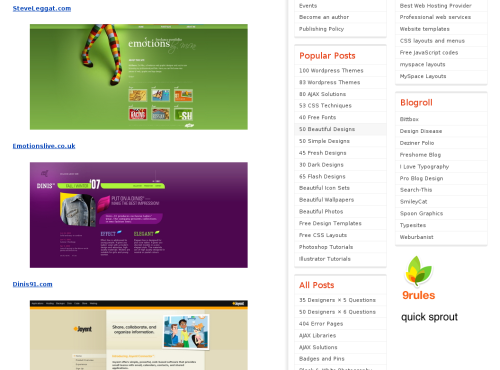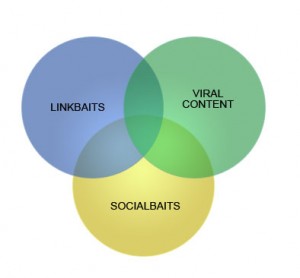On Linkbaits, Socialbaits and Viral Content
If you have been involved with online marketing, web publishing or blogging for a while, I am sure that you have come across the terms linkbait, socialbait and viral content at least once.

Despite the widespread in their usage, however, we still don’t have a clear grasp on their meanings.
What is a linkbait? What is a socialbait? What is viral content? Are they all the same? What characteristics they share? What differences they have? Are they good? Bad? For whom?
Those are just some of the questions that are floating around, and I thought that it would be interesting to write an article trying to answer them.
Keep in mind that the ideas presented below are merely an exploration of our understanding of those terms, and they don’t have the pretension to become the ultimate truth on the topic.
Linkbaits
The first thing we need to lay down is a definition for each of the three terms, right? Let’s take a look at how other people defined linkbaits in the past.
Darren Rowse from Problogger wrote:
The term linkbaiting is a one that seems to have surfaced over the past 12 or so months and that is used by webmasters to describe a variety of practices - all of which seek to generate incoming links to a website or blog from other sites.
It is actually a difficult term to be definative about as it covers a lot of different practices ranging from running awards or competitions, through to writing attacking posts on high profile bloggers in the hope of them biting back and linking to you, through to providing other bloggers or site owners with tools (with embedded links back to your own site) that they can put on their blogs (we’ll run through more linkbaiting techniques in one of my next posts in this series).
In reality the term ‘linkbaiting’ is a new term for something that webmasters have been doing for many years. From my earliest days of blogging four years ago I know I saw people doing lots of things to get links (even though the term was never used).
Matt Cutts, head of Google’s web spam team, wrote:
On a meta-level, I think of “linkbait” as something interesting enough to catch people’s attention, and that doesn’t have to be a bad thing. There are a lot of ways to do that, including putting in sweat-of-the-brow work to generate data or insights, or it can be as simple as being creative. You can also say something controversial to generate discussion (this last one gets tired if you overuse it, though). Sometimes even a little bit of work can generate a reason for people to link to you.
Stuart Brown from Modern Life is Rubbish wrote:
Linkbait is essentially a piece of content placed on a web page - whether it’s an article, blog post, picture, or any other section of cyberspace - that is designed for the specific intention of gathering links from as many different sources as possible.
With the rise of the blogosphere, meritocracy and social bookmarking sites, all it takes is one interesting page on a site, someone to notice the page, and a few people to share the link - and before you know it, you’ve accrued a large number of links across a wide variety of sites.
As you can see the definitions have a lot in common. Putting it as briefly as possible, I would say that a linkbait is a piece of online content (e.g., an article, a video, a picture, a quiz, a game or anything else) which is created with the purpose of attracting as many links from external websites as possible.
Linkbait Examples
Sometimes it is easier to show than to describe with words, so let’s take a look at some real linkbait examples.
The first one is the Blogger Spelling Test. If you visit that page you will notice that the quiz was moved somewhere else, but the backlinks are still in place. Yahoo! reports 350 of them.
That quiz is an example of blatant promotional linkbait because it was targeted at a very specific linkerati (i.e. people that are able to link) segment - bloggers - and because right after taking the quiz you are be presented with your score on a badge (ego play) and an HTML code, encouraging you to put it on your site. Needless to say that the HTML code already comes with an embedded link to the quiz.

Another sign that this linkbait was a pure marketing effort comes from the fact that the main website behind it is a dating site…
Most linkbaits, however, are not crafted with such blatant promotional goals mind. They are rather created to provide valuable information to the audience of the website where they will be published. In other words, they are genuine.
Smashing Magazine illustrates this concept well. They often publish huge lists with beautiful designs, photoshop tutorials, fonts and the like. We certainly can classify those as linkbaits, but they are created with the main purpose of providing value to the core audience of the website, and not to cheaply attract backlinks.

As one would probably have guessed, those value-based linkbaits tend to perform better. The article 50 Beautiful CSS-Based Web-Designs in 2006 has attracted almost 3,000 backlinks since it was launched, far more than the quiz we mentioned above.
Socialbaits
The term socialbait has not been used as extensively, and many people would just consider it a synonym to linkbait. I believe the two concepts have some differences, however, and therefore they deserve a separate classification.
Obviously socialbaits will tend to behave as linkbaits most of the times, because something that goes hot on social media and social bookmarking websites will inevitably receive many backlinks. The opposite is not true, however, as some forms of linkbait perform poorly on social media (one example being online quizzes).
Secondly, there are many situations where a blogger or web publisher is more concerned with page views and raw traffic than with backlinks. One example would be website owners that have CPM advertising deals in place (a form of advertising that pays based on how many impressions the ad will receive). As a result, he might end up crafting content that has high chances of becoming popular on social media, but that is not necessarily going to attract a huge amount of backlinks.
My definition of socialbait is: a piece of online content (e.g., an article, a video, a picture, a quiz, a game and or anything else) which is created with the purpose of receiving as much traffic as possible from social media websites.
Socialbait Example
Again let’s take a look at a real example to understand the concept. Sometime ago ValleyWag published the 13 Signs You May Be A Digg Power User picture.

This is a clear socialbait example, because the article and the picture were specifically crafted to target the Digg audience.
The numbers back up this view. The article received over 2,000 diggs, 245 comments on the Digg website, and I am sure it also generated a sheer amount of traffic when it was released.
Was it as successful in attracting backlinks? Not at all. In fact Yahoo! reports it only has 145 external links pointing there, which is quite a small number for an article that received over 2,000 diggs.
Viral Content
Seth Godin was the first to use the term “viral” as applied to ideas and online content, so we must quote him here:
For an idea to spread, it needs to be sent and received.
No one “sends” an idea unless:
a. they understand it
b. they want it to spread
c. they believe that spreading it will enhance their power (reputation, income, friendships) or their peace of mind
d. the effort necessary to send the idea is less than the benefitsNo one “gets” an idea unless:
a. the first impression demands further investigation
b. they already understand the foundation ideas necessary to get the new idea
c. they trust or respect the sender enough to invest the timeThis explains why online ideas spread so fast but why they’re often shallow. Nietzsche is hard to understand and risky to spread, so it moves slowly among people willing to invest the time. Numa Numa, on the other hand, spread like a toxic waste spill because it was so transparent, reasonably funny and easy to share.
To put it in a shorter form, viral content is a piece of online content (e.g., an article, a video, a picture, a quiz, a game or anything else) that raises certain emotions on people, creating an urge on them to share that content in one way or another.
One key difference between viral content and linkbaits/socialbaits is the fact that the former might emerge spontaneously, while the latter is usually created on purpose.
I would also say that viral content is stronger that linkbaits/socialbaits, exactly because it hits harder on people’s emotions. Think about the spelling quiz we mentioned earlier. Sure it was a successful linkbait, and it managed to generate hundreds of backlinks. But it was not viral, it didn’t installed on people an urge to share it.
Viral Content Examples
A classic example of viral content is the Star Wars Kid video. It features a kid playing with a staff, and apparently the kid is unaware that he is being filmed.

The guy who released it on the web knew it was quite funny, but he was not expecting the video to spread like a virus!
It has almost 10 million views on YouTube, over 45,000 comments, its own Wikipedia entry, and if you Google “Star Wars Kid” with quotation marks you will get around 370,000 results.
This video illustrates how viral content can emerge spontaneously on the web.
There are cases where one person manages to create viral content with specific goals in mind as well.
Seth Godin himself used this strategy when he released his ebook Unleashing the Ideavirus on the Internet. It was easy to understand, useful, easy to share (the ebook was free and downloadable), and by spreading it people would be increasing their own powers (because other people would be thankful to them).

The result? One of the most popular ebooks ever! If you don’t have a copy of it, you are with the minority.
Putting It All Together
At this point one should be asking himself: “What is the relationship between those three concepts? Are they related? Are they the same?”
In my opinion they are all distinct, although they have similarities and can overlap sometimes.
A linkbait might also be viral content, but that is not necessarily the case.
A linkbait might be a socialbait at the same time, but that is not necessarily the case.
A socialbait might also be viral content, but that is not necessarily the case.
Viral content, finally, might emerge from linkbaits and socialbaits, but that is not necessarily the case.
We can represent those relationships easily with a Venn diagram, as the image below shows:

Are Linkbaits, Socialbaits and Viral Content Good Or Bad?
Finally, we need to answer the question of whether those concepts and strategies are a good or a bad thing.
Darren Rowse, on the same article we mentioned earlier, wrote:
Linkbaiting is often written about in negative terms. I regularly see people writing off a post that others have written or a comment others have left as ‘just being linkbait’.
I personally don’t like the term ‘linkbaiting’ on some levels as it does seem to have negative connotations. ‘Baiting’ has a sense of trying to trick or trap an unsuspecting person or thing into doing something that they don’t really want to do. While this is accurate with some forms of linkbaiting it is not true with others.
There is a lot of debate around both the term ‘linkbaiting’ and some of the practices that people talk about it incorporating. Some argue strongly that it is just a by-product of quality content, others argue that many linkbaiting strategies border on spam, others seem to talk about linkbait as being the answer to all web promotional problems (increasingly SEO companies are offering linkbaiting services).
My own opinion on whether link bait is good or bad is that it depends upon the type of link baiting that you’re talking about. I think some techniques that people use are just good standard blogging techniques - while other things that people do in the pursuit of links are destructive to the blogging community and I’d argue against them.
And Stuart Brown wrote:
Of course, that depends on the content in question and the intention behind it - but one advantage with social linking and meritocracy based sites is that the dull, spammy and unworthy content generally sinks to the bottom, leaving the good, well crafted stuff to float to the top.
As you can see there is no clear cut. It all depends on how the content is elaborated (i.e. to provide value vs. to trick people) and with what intentions. I think Stuart is right on the mark though when he mentions that the web itself regulates the market. It is a meritocracy after all, and you can’t fool hundreds of thousands of savvy users.
I think exploring the concept of linkbaits, socialbaits and viral content is therefore important and valid for anyone involved with online marketing. You just need to make sure you approach those strategies from the right side.
What about you, do you agree with my definitions? Do you think linkbaits, socialbaits and viral content can be part of a honest online marketing strategy? Speak your mind!















Post a Comment